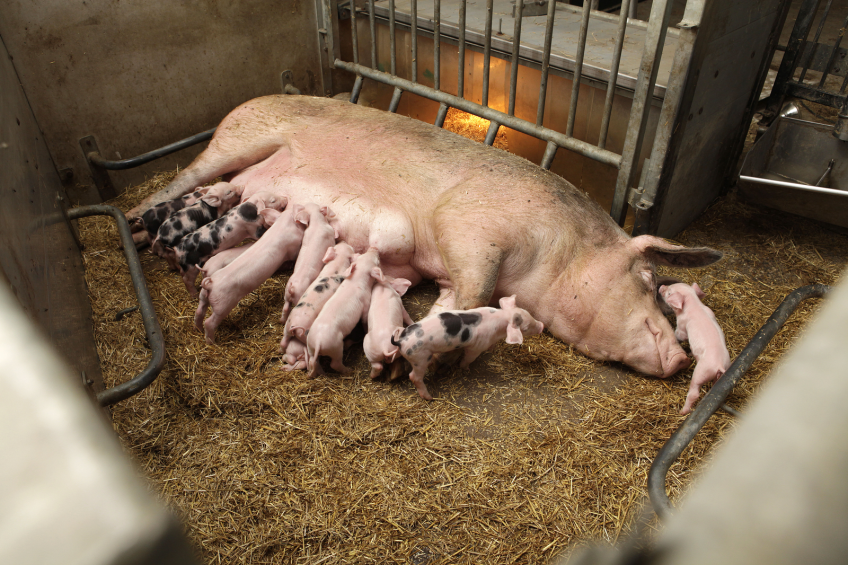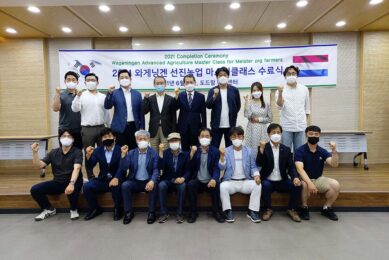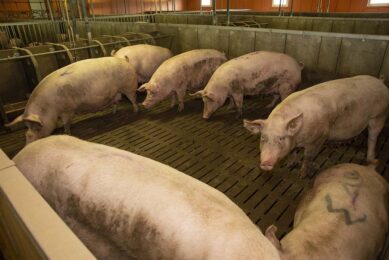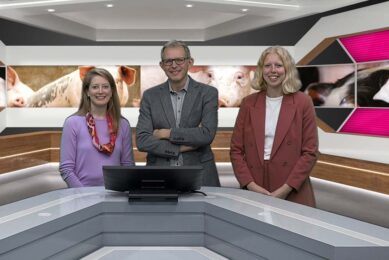Does more piglet welfare mean more piglet health?

Some say better animal welfare leads to better animal health, others however strongly oppose this view. As is more often the case, there is something to say for both opinions. How to get the best of both worlds?
By Monique Pairis-Garcia, Anna Johnson and Alejandro Ramirez, Iowa State University, Ames, IA, United States
Over the past decade there has been increased interest from the public and retailers selling animal protein in regards to on farm animal welfare. This has resulted in numerous on-farm assessments, third party auditing and state legislation initiatives. Animal welfare can be evaluated using a set of guidelines, called the Five Freedoms (see box).
According to Dr McGlone and Dr Johnson in 2003, defining piglet welfare can be challenging, still, those working closely with piglets know adequate or inadequate welfare when it is observed. Piglets that are sick or injured have clearly compromised welfare, while piglets in an inadequate environment, although not clearly in a state of poor welfare, are at risk of experiencing poor welfare. For example, if piglets are ‘stressed’ and have a low or suppressed immune system, they could be at risk of experiencing poor welfare if exposed to a pathogen. For the neonatal piglet, an animal capable of withstanding considerable stress, management of its welfare is more about reducing the risk of welfare problems than about reducing the situations where welfare is presently poor. The primary welfare-impacting features of the environment for the piglet are its thermal, social and physical environment as well as the people who work with piglets.
In this article the specific focus is on piglet welfare. The relationship between improving welfare and the health status of the animal is explored. The two areas of focus will be:
- Management procedures performed on piglets;
- Sow and piglet housing.
Management procedures
Routine production procedures in the swine industry have been criticised due to elicitation of pain without the use of analgesia or anesthesia; specifically, teeth clipping, castration and tail docking. Inducing pain without the use of analgesics compromises the third freedom of animal welfare defined as “freedom from pain, injury and disease”, and may have deeper implications as it relates to the piglet health and productivity.
Teeth clipping
Teeth clipping is conducted with the aim of reducing facial injuries to piglets and damage to sow’s udder. A study conducted by Dr Weary and Dr Fraser in 1999 compared piglets with fully clipped teeth, partially clipped teeth and intact teeth with all piglets of a litter receiving one treatment (clipped, partial clipped, intact) on one side of the mouth and a different treatment on the other side of the mouth. This study found very little, to no observable damage to the sow’s udder when teeth remained intact but facial injuries on piglets were evident. Mortality rates between treatments were not different suggesting facial injuries did not result in further morbidity or mortality. This study also found that piglets with fully intact teeth gained more weight during the first week of life (154 ± 7 g/day) and appeared to have a competitive advantage over their litter mates. Although a difference in weight gain was only detected within the first week of life, allowing piglets to keep their teeth intact may have productivity benefits for piglets. Eliminating or reducing teeth clipping on farm may not only improve piglet welfare by eliminating a procedure in which the animal may experience pain associated with pulp cavity inflammation, but may also improve performance by allowing smaller piglets to compete more equally for resources with its littermates. In addition, by eliminating teeth clipping health risks associated with improper teeth clipping can be avoided, such as infection and abscess formation.
Castration
Castration is primarily conducted to prevent boar taint in meat. Castration has been determined to cause short term pain. Castration includes several events likely to be painful including the scrotal incision, extraction of the testes and severing of the spermatic cords. However, growth and health performance of piglets does not appear to be affected by this procedure. Movement towards alternative methods of castration (castration with analgesic/ anaesthetic, immunocastration) is driven primarily from the concern of animal pain rather than health.
Tail docking
Tail docking is performed to reduce the risk of tail biting in the later finisher stages. Short term spontaneous pain associated with tail docking results primarily by the physical trauma of the skin and muscle. However neuroma formation at the site of incision may result in chronic pain throughout the piglet’s life. Not performing tail docking does have welfare implications later on. Data collected from UK abattoirs in 2011 found that the odds of a tail docked pig being not bitten were 2.73 times better than non-tail docked pigs. Tail biting can lead to serious injury, as tail bitten pigs are more likely to exhibit lung abscesses, pleuritis, and tail injury. Depending on the severity of the bite, growth and mortality may be affected. Tail biting is a complex multi-factorial issue which also includes careful consideration and evaluation of the environment, management of resources, stocking density and husbandry practices. All of these factors needed to be evaluated before tail biting can be managed without the use of tail docking.
Sow and piglet housing
Housing and environmental conditions of pigs have generated considerable interest in the US, Australia and the EU. As it relates to piglets, the dimensions of the farrowing stall, protective area for the piglet and sow access to bedding have been the primary areas of focus related to sow and piglet housing. Providing the sow with bedding material and increased space in farrowing allows the sow access to perform nest-building. Nest-building material and increased space has been identified as important for the sow and when reduced can result in detrimental piglet welfare through increased piglet crushing, thermoregulatory issues and decreased piglet immunity. These studies suggest that the farrowing environment may have an effect on overall piglet health and survivability. Current production systems have adapted the environment to protect piglets including the implementation of heat lamps and mats, protective zones from sows, and individual piglet care and management. Optimising the welfare of both the sow and piglet can be challenging in the farrowing environment as we must balance the needs of the piglet and its environment with that of the sow.
The three greatest welfare concerns that arise for the piglet in the farrowing environment include mortality due to crushing, starvation and chilling and increased morbidity due to illness and injury. When evaluating facility design as it relates to piglet mortality and morbidity, one of the primary factors affecting piglet mortality is inadequate flooring. Providing an environment that the sow can move without slipping or falling is critical for minimising piglet death due to crushing.
Housing options include farrowing stalls, indoor/ outdoor group pens, farrowing huts, and larger stalls. Median piglet mortality for litters reported in stalls, small pens or modified stalls and open pens were 12.7%, 11.3% and 24.2% respectively. This suggests that stalls and modified stalls have a greater advantage over open pens when it relates to piglet mortality. Although this has clear health and welfare benefits for the piglet, sow welfare may be compromised as sows farrowing in stalls will experience social isolation, prolonged confinement, and generally will not have access to bedding.
In summary, the ideal situation for a producer would be to optimise piglet health and welfare while eliminating or minimising pain and suffering. However, in some instances, improving the welfare of the animal may negatively impact health immediately or in a later stage of development. Therefore when evaluating husbandry practices, facility design, and production procedures, one should always balance improving animal welfare while maintaining a premier level of health and production whilst recognising the economic implications that these management and housing options may have on the producer.
Five freedoms of animal welfare
1. Freedom from hunger and thirst
2. Freedom from discomfort
3. Freedom from pain, injury and disease
4. Freedom to express normal behaviour
5. Freedom from fear and distress
[Source: Pig Progress Special – Piglet Health, 2014]
 Beheer
Beheer








 WP Admin
WP Admin  Bewerk bericht
Bewerk bericht